Researchers from the German Aerospace Center (DLR) have fabricated a semitransparent solar cell based on ultra-thin hydrogenated amorphous multiple quantum wells (MQWs) made of silicon and germanium (Si/Ge).
“Our novel semi-transparent solar cell technology could afford several integration opportunities into diverse applications like glass façades in buildings and windows, sunroofs in vehicles and greenhouses for agrivoltaics,” researcher Hosni Meddeb told pv magazine. “The customized design capabilities could enable multifunctional utilization beyond solar energy harvesting such as aesthetic appearance, visual comfort and thermal management.”
Quantum wells are thin nanostructures inserted into the cell layers to alter the bandgap and other properties. In previous PV research, these nanostructures were used as single quantum wells (SQWs) and the novelty of this research consists in giving them a “multiple” configuration.
“This allows extra degree of freedom for both optical design and bandgap engineering,” the scientists said, noting the MQWs offer advantages for both photovoltaic performance and transparency.
They built several solar cells with either MQWs or SQWs and compared their performance at standard illumination conditions to assess the extent of the advantages provided by the former. They deposited front and back electrodes via the DC magnetron sputtering technique and fabricated the semiconductor functional layers through low-temperature Plasma Enhanced Chemical Vapor Deposition (PECVD) method at 13.56 MHz. They also annealed the cells at 100 C for 30 min.
Popular content
The academics said that a cell built with six 2.5-nanometer MQWs performed better in terms of open-circuit voltage and fill factor than a device based on one 20-nanometer SQW. The champion cell achieved a power conversion efficiency of 3.4% and an average visible transmission level of around 33%.
“A corresponding light utilization efficiency above 1.1% is achieved, which can be considered as one of the highest among inorganic semi-transparent solar cell technologies,” they explained.
The research group described the cell technology in “Novel semi-transparent solar cell based on ultrathin multiple Si/Ge quantum wells,” which was recently published in Progress in Photovoltaics. It is currently trying to establish a techno-economic and ecological assessment for the application of its novel semi-transparent solar cell technology in building-integrated PV. Further non-technical considerations and detailed cost estimations are expected in the future.
“Our proposed ultra-thin-film PV concept could provide promising technological advantages in terms of low material consumption, fast fabrication and cost reduction,” Meddeb explained. “Along with the cost-effective and industrial-compatible fabrication process, large-scale modularization is similar to mature thin-film PV technologies. This would facilitate the technology transfer toward manufacturing and commercialization level.”
This content is protected by copyright and may not be reused. If you want to cooperate with us and would like to reuse some of our content, please contact: editors@pv-magazine.com.



1 comment
By submitting this form you agree to pv magazine using your data for the purposes of publishing your comment.
Your personal data will only be disclosed or otherwise transmitted to third parties for the purposes of spam filtering or if this is necessary for technical maintenance of the website. Any other transfer to third parties will not take place unless this is justified on the basis of applicable data protection regulations or if pv magazine is legally obliged to do so.
You may revoke this consent at any time with effect for the future, in which case your personal data will be deleted immediately. Otherwise, your data will be deleted if pv magazine has processed your request or the purpose of data storage is fulfilled.
Further information on data privacy can be found in our Data Protection Policy.